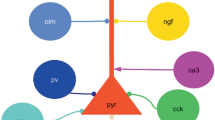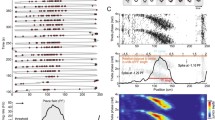Abstract
Phase precession is one of the most well known examples within the temporal coding hypothesis. Here we present a biophysical spiking model for phase precession in hippocampal CA1 which focuses on the interaction between place cells and local inhibitory interneurons. The model’s functional block is composed of a place cell (PC) connected with a local inhibitory cell (IC) which is modulated by the population theta rhythm. Both cells receive excitatory inputs from the entorhinal cortex (EC). These inputs are both theta modulated and space modulated. The dynamics of the two neuron types are described by integrate-and-fire models with conductance synapses, and the EC inputs are described using non-homogeneous Poisson processes. Phase precession in our model is caused by increased drive to specific PC/IC pairs when the animal is in their place field. The excitation increases the IC’s firing rate, and this modulates the PC’s firing rate such that both cells precess relative to theta. Our model implies that phase coding in place cells may not be independent from rate coding. The absence of restrictive connectivity constraints in this model predicts the generation of phase precession in any network with similar architecture and subject to a clocking rhythm, independently of the involvement in spatial tasks.









Similar content being viewed by others
References
Amaral, D., & Lavenex, P. (2006). Hippocampal neuroanatomy. In P. Andersen, R. Morris, D. Amaral, T. Bliss, & J. O’Keefe (Eds.), The hippocampus book. New York: Oxford University Press.
Baker, J., & Olds, J. (2007). Theta phase precession emerges from a hybrid computational model of a CA3 place cell. Cognitive Neurodynamics, 1(3), 237–248. doi:10.1007/s11571-007-9018-9.
Bendels, M., & Leibold, C. (2007). Generation of theta oscillations by weakly coupled neural oscillators in the presence of noise. Journal of Computational Neuroscience, 22(2), 173–189. doi:10.1007/s10827-006-0006-6.
Bose, A., Booth, V., & Recce, M. (2000). A temporal mechanism for generating the phase precession of hippocampal place cells. Journal of Computational Neuroscience, 9(1), 5–30. doi:10.1023/a:1008976210366.
Buzsáki, G. (2002). Theta oscillations in the hippocampus. Neuron, 33(3), 325–340. doi:10.1016/S0896-6273(02)00586-X.
Ego-Stengel, V., & Wilson, M. A. (2007). Spatial selectivity and theta phase precession in CA1 interneurons. Hippocampus, 17(2), 161–174. doi:10.1002/hipo.20253.
Freund, T. F., & Buzsaki, G. (1996). Interneurons of the hippocampus. Hippocampus, 6(4), 347–470. doi:10.1002/(SICI)1098-1063(1996)6:4<347::AID-HIPO1>3.0.CO;2-I.
Geisler, C., Diba, K., Pastalkova, E., Mizuseki, K., Royer, S., & Buzsáki, G. (2010). Temporal delays among place cells determine the frequency of population theta oscillations in the hippocampus. Proceedings of the National Academy of Sciences, 107(17), 7957–7962. doi:10.1073/pnas.0912478107.
Hafting, T., Fyhn, M., Bonnevie, T., Moser, M.-B., & Moser, E. I. (2008). Hippocampus-independent phase precession in entorhinal grid cells. [doi:10.1038/nature06957]. Nature, 453(7199), 1248–1252, http://www.nature.com/nature/journal/v453/n7199/suppinfo/nature06957_S1.html.
Halasy, K., Buhl, E. H., Lorinczi, Z., Tamas, G., & Somogyi, P. (1996). Synaptic target selectivity and input of GABAergic basket and bistratified interneurons in the CA1 area of the rat hippocampus. Hippocampus, 6(3), 306–329. doi:10.1002/(SICI)1098-1063(1996)6:3<306::AID-HIPO8>3.0.CO;2-K.
Harris, K. D., Henze, D. A., Hirase, H., Leinekugel, X., Dragoi, G., Czurko, A., et al. (2002). Spike train dynamics predicts theta-related phase precession in hippocampal pyramidal cells. [doi:10.1038/nature00808]. Nature, 417(6890), 738–741, http://www.nature.com/nature/journal/v417/n6890/suppinfo/nature00808_S1.html.
Harvey, C. D., Collman, F., Dombeck, D. A., & Tank, D. W. (2009). Intracellular dynamics of hippocampal place cells during virtual navigation. Nature, 461(7266), 941–946. doi:10.1038/nature08499.
Hasselmo, M. E., Brandon, M. P., Yoshida, M., Giocomo, L. M., Heys, J. G., Fransen, E., et al. (2009). A phase code for memory could arise from circuit mechanisms in entorhinal cortex. Neural Networks, 22(8), 1129–1138. doi:10.1016/j.neunet.2009.07.012.
Hines, M. L., Morse, T., Migliore, M., Carnevale, N. T., & Shepherd, G. M. (2004). ModelDB: A database to support computational neuroscience. [Research support, U.S. Gov’t, P.H.S.]. Journal of Computational Neuroscience, 17(1), 7–11. doi:10.1023/B:JCNS.0000023869.22017.2e.
Huxter, J., Burgess, N., & O’Keefe, J. (2003). Independent rate and temporal coding in hippocampal pyramidal cells. [doi:10.1038/nature02058]. Nature, 425(6960), 828-832, http://www.nature.com/nature/journal/v425/n6960/suppinfo/nature02058_S1.html.
Kamondi, A., Acsády, L., Wang, X. J., & Buzsáki, G. (1998). Theta oscillations in somata and dendrites of hippocampal pyramidal cells in vivo: Activity-dependent phase-precession of action potentials. Hippocampus, 8(3), 244–261. doi:citeulike-article-id:436284.
Lengyel, M., Szatmáry, Z., & Érdi, P. (2003). Dynamically detuned oscillations account for the coupled rate and temporal code of place cell firing. Hippocampus, 13(6), 700–714. doi:10.1002/hipo.10116.
Loewenstein, Y., Yarom, Y., & Sompolinsky, H. (2001). The generation of oscillations in networks of electrically coupled cells. Proceedings of the National Academy of Sciences, 98(14), 8095–8100. doi:10.1073/pnas.131116898.
Mehta, M. R., Lee, A. K., & Wilson, M. A. (2002). Role of experience and oscillations in transforming a rate code into a temporal code. [10.1038/nature00807]. Nature, 417(6890), 741–746.
O’Keefe, J., & Burgess, N. (2005). Dual phase and rate coding in hippocampal place cells: Theoretical significance and relationship to entorhinal grid cells. Hippocampus, 15(7), 853–866.
O’Keefe, J., & Recce, M. L. (1993). Phase relationship between hippocampal place units and the EEG theta rhythm. Hippocampus, 3(3), 317–330. doi:10.1002/hipo.450030307.
Ross, S. M. (2002). Simulation (3rd ed.). San Diego: Academic.
Shepherd, G. M. (1998). The synaptic organization of the brain (4th ed.). New York: Oxford University Press.
Skaggs, W. E., McNaughton, B. L., Wilson, M. A., & Barnes, C. A. (1996). Theta phase precession in hippocampal neuronal populations and the compression of temporal sequences. Hippocampus, 6(2), 149–172. doi:10.1002/(sici)1098-1063(1996)6:2<149::aid-hipo6>3.0.co;2-k.
Tsodyks, M. V., Skaggs, W. E., Sejnowski, T. J., & McNaughton, B. L. (1996). Population dynamics and theta rhythm phase precession of hippocampal place cell firing: A spiking neuron model. Hippocampus, 6, 271–280.
Acknowledgements
Research funded by the European Regional Development Fund through the programme COMPETE and by the Portuguese Government through the FCT - Fundação para a Ciência e a Tecnologia under the project PEst-C/MAT/UI0144/2011. Luísa Castro was supported by the grant SFRH/BD/46329/2008 from FCT. The authors would like to thank the reviewers for important suggestions.
Author information
Authors and Affiliations
Corresponding author
Additional information
Action Editor: Alessandro Treves
Rights and permissions
About this article
Cite this article
Castro, L., Aguiar, P. Phase precession through acceleration of local theta rhythm: a biophysical model for the interaction between place cells and local inhibitory neurons. J Comput Neurosci 33, 141–150 (2012). https://doi.org/10.1007/s10827-011-0378-0
Received:
Revised:
Accepted:
Published:
Issue Date:
DOI: https://doi.org/10.1007/s10827-011-0378-0




